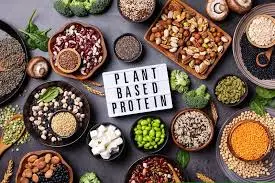Plant-Based Protein: The Power of Plants in Modern Nutrition
Introduction
In recent years, plant-based protein has surged into the spotlight—not just as a trend, but as a major paradigm shift in how we view food and nutrition. Whether motivated by health, environmental concerns, or ethical values, more people are exploring alternatives to animal protein. But can plants really pack the same punch when it comes to muscle-building, metabolic support, and overall wellness?
The answer is a yes—when approached with knowledge and balance. Let’s dive deep into the world of plant-based protein , here we will discuss what is plant base d protein, why it matters, where to find it, and how to optimize it in your diet.
What Is Plant-Based Protein?
Plant-based protein is derived from plant sources such as legumes, grains, nuts, seeds, vegetables, and certain algae. Unlike animal proteins, which are complete by default (meaning they contain all nine essential amino acids), many plant proteins are considered “incomplete” on their own. However, a well-rounded plant-based diet easily provides all essential amino acids when different protein sources are combined. Now explore plant based protein and its benefits.
Why Choose Plant-Based Protein?

Health Benefits
Heart Health
Diets high in plant protein are associated with lower blood pressure, improved cholesterol levels, and reduced risk of cardiovascular diseas
Lower Inflammation
Plants naturally contain antioxidants, phytochemicals, and fiber—all of which help reduce chronic inflammation.
Weight Management
Plant proteins are often accompanied by fiber, which increases satiety and helps regulate appetite.
Environmental Sustainability
Production of plant protein typically requires less land, water, and energy compared to animal farming. It also results in fewer greenhouse gas emissions, making it a more eco-friendly choice.
Ethical Considerations
Many choose plant-based diets to avoid animal cruelty and to support more humane food systems.
Top Sources of Plant-Based Protein
Here’s a breakdown of some nutrient-dense, protein-rich plant foods:
Source Protein (per 100g, cooked) Notable Nutrients
Lentils 9g Iron, folate, fiber
Chickpeas 8.9g Manganese, B6, magnesium
Quinoa 8.1g Complete protein, magnesium
Tofu (firm) 17g Calcium, iron, isoflavones
Tempeh 19g Probiotics, B vitamins
Edamame 11g Iron, calcium, fiber
Hemp Seeds 31g Omega-3s, magnesium
Chia Seeds 17g Fiber, calcium, omega-3s
Pumpkin Seeds 30g Zinc, antioxidants
Spirulina 57g B12 analogues, iron, chlorophyll
The Myth of Incomplete Protein
It’s a common misconception that you need to eat all essential amino acids in one meal to build muscle or maintain health. In actual, the body maintains a level of amino acids throughout the day. So, as long as your diet contains a variety of plant protein sources over the course of the day, you’re covered.
Pairing legumes with grains (like beans and rice) or nuts with whole grains (like almond butter on whole grain bread) ensures a complete amino acid profile.
Plant-Based Protein and Fitness
Can plant-based athletes thrive? Absolutely. Numerous professional athletes—runners, bodybuilders, and Olympians—are thriving on plant-centric diets.
Key Tips for Active Individuals
Eat Enough Calories
Plant foods are less calorie-dense, so you may need larger portions to meet energy needs.
Focus on High-Protein Staples:
Tempeh, tofu, seitan, legumes, and protein-fortified plant milks can help hit daily protein goals.
Supplement Wisely
Depending on your diet, consider B12, vitamin D, and omega-3 supplements.
Plant-Based Protein Powders
For convenience, especially around workouts, there’s a growing market for plant protein powders made from peas, brown rice, hemp, pumpkin seeds, and blends. Look for products with minimal additives, and opt for those that combine multiple protein sources for a more balanced amino acid profile.
Challenges and How to Overcome Them
Digestibility
Some people experience bloating or discomfort with legumes or cruciferous vegetables. Cooking thoroughly, soaking beans, or using digestive aids can help.
Taste Fatigue
Vary your plant proteins with global cuisines—Indian dal, Mediterranean hummus, Asian tofu stir-fries, and Latin-inspired quinoa bowls.
Hidden Sugars in Processed Options:
Many plant-based meats are high in sodium and additives. Whole food sources are preferable for daily use.
Conclusion: A Balanced Approach
Plant-based protein is more than a viable alternative—it’s a nutritional powerhouse when chosen thoughtfully. Whether you’re looking to eat more sustainably, improve your health, or explore new flavors, incorporating plant protein into your diet can be both delicious and deeply rewarding.

